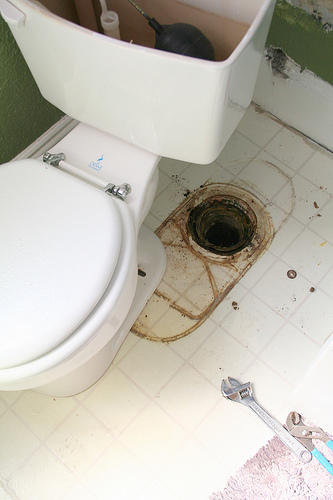When a toilet gets clogged, perhaps the first impulse would be to call a plumber. But actually, knowing how to fix a clogged toilet is easy enough that one needn’t have to go through all that trouble. Sure, it’s a messy job, and unfortunately someone has to do it, but it isn’t as difficult as it would seem.
Before fixing a clogged toilet, its water should first be shut off. The toilet’s water shut-off is usually located just underneath the toilet tank. Be sure that the handle is completely turned clock-wise in order to shut off the flow of the water. If one is unable to find the water shut-off below the tank, one will just have to turn off the house’s water while toilet repairs are going on.
If the toilet is overflowing with water or filled up with sewage, this should all be cleaned up so that it does not completely ruin the bathroom. It is vital to one’s health to do this so that they wouldn’t have to be wading in wastes while working on the toilet. Then, use a toilet plunger in order to unclog the toilet. It is important to keep in mind that the type of plunger that is used in fixing a sink is not quite the same as the plunger used for a toilet. One difference is that a toilet plunger is equipped with an extra lip which serves to seal the drain of the toilet during plunging. A toilet plunger resembles a ball that has one-fourth of it cut off, whereas a sink plunger resembles a ball that had only been cut in half.
Position the toilet plunger in such a manner that it is covering the drain of the toilet. Push down the toilet plunger; if there is no suction felt, either the plunger needs to be repositioned or more water should be added. Once there is suction, the plunger should be slowly moved up and down. Once a rhythm is established, the speed should be increased until 10 cycles at the least have been completed. It is by this point that a clogged toilet would usually drain. But if the toilet is draining slowly or isn’t draining at all, the entire procedure will have to be repeated. Each time that one plunges, one should always finish using the exact push or pull action. Otherwise, one may be able to remove the clog only to end up getting it stuck back in.
If the toilet remains clogged even after plunging, one will have to use a toilet auger. Again, a toilet auger is different from a sink auger, even though they may look similar. A toilet auger is distinguished by its outer sleeve, which protects the toilet’s porcelain. The auger is inserted into the drain and pushed down until it can’t go further down anymore. Preferably, one would have been able to reach the obstacle clogging the toilet. Hold the auger firmly in position, and then turn it clock-wise. This will push the auger forward, naturally pushing the obstruction out of its way. If the toilet refuses to drain, try to reverse and withdraw the auger. The auger’s head sometimes spears the obstruction, which can be withdrawn along with the toilet auger. If it still isn’t working, the auger would have to be re-inserted and the clog pushed down all the way into the drain.



